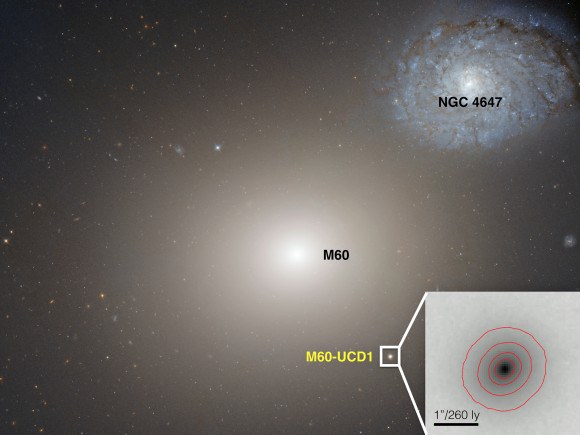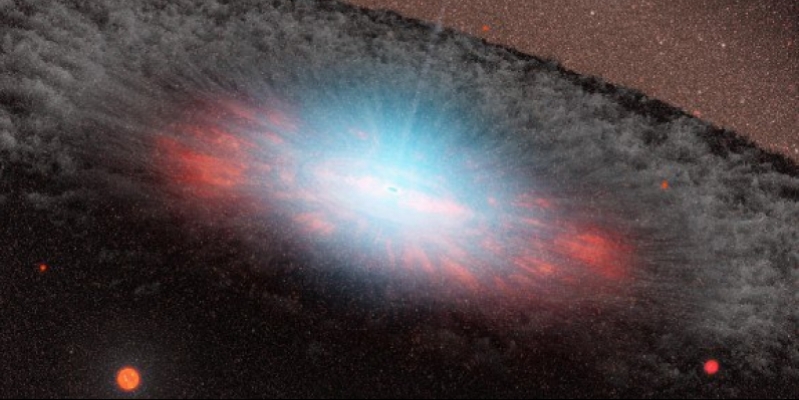Can you imagine for a man 500 times smaller creature? Well, very roughly speaking, it could be any chisel or a frog. And do you imagine that for someone that is 500 times smaller in the body, scientists find normal-sized human heart? Just about the whole theory upside down forcing the paradox of astronomers discovered there in the sky.
What kind of galaxy, if its diameter - only 157 light-years? At 157 thousand., But just 157 light-years! Ie. 500 times less than our own Milky Way galaxy. That is hardly visible in a galaxy made perplexing discovery - that sits in the center of the giant supermassive black hole. Moreover, investigators are inclined to believe that it is - not any exception and the rule. This means that all supermassive black abysses formation theories can be revised.
Such a framework would exist if astrophysicists discovered more of these dwarf galaxies with huge black holes. As soon as the discovery of the authors and are now taken, completed the dwarf galaxies M60-UCD1 analysis and confirmed its center Tunantes black monster. Galaxy Mini is one of only about 50 known astronomers like mini-caliber neighboring galaxies, clusters of galaxies.
"She - just like a needle prick hole in the endless sky" - a miniature version of the M60 galaxy-UCD1 press conference described the University of Utah (USA), an astrophysicist Anil Seth.
The researcher said that by looking at the movement of the stars in the galaxy charts, compiled from ground-based telescopes in Hawaii operating the Gemini North Telescope data, realized that something special going on in the galaxy. M60-Star center UCD1 flew significantly higher speeds than their sisters in the galaxy periphery. The speed of this type of stars in galaxies are not typical.
"As soon as he saw the movement of the stars maps understood to have found something unusual", - says Mr Seth.
M60-UCD1 according to their weight is the exclusive galaxy. Last year, Mr Seth and his colleagues discovered and announced that it is the densest neighbor galaxy, where stars are crammed 25 times more than our Milky Way. In addition, the M60-UCD1 is one of the brightest galaxies of all, is discovered by astronomers. Of course, this is influenced by the fact that this dwarf is relatively close to Earth - to our planet contributes around 54 million. light years away. Same distance to the huge M 60 galaxy, around which it orbits the dwarf. These galaxies spend only 20 thousand. light years away.

Until now it was known that the supermassive black hole lies only much larger galactic centers (such hiding and center of our galaxy). However, how they ended up there, is not yet clear. But after the discovery of the M60-UCD1 became even less clear.
The point is that a miniature M60-UCD1 center throws a huge black hole mass is approximately 15 percent. the total mass of the galaxy. This equates to 21 million. Saul. By comparison, the Milky Way's super-massive black hole is less than 1 percent. the total mass of our galaxy.
Given the fact that astronomers have discovered a very small number of particularly small galaxies, which are M60-UCD1 some basic properties of the baffle. For example, it is likely that this type of galaxy mass is higher than that imposed in the light of the stars.
Some astronomers speculate that this may be due to the fact that these galaxies are more massive stars. However, Mr Sethi carry M60-Stars UCD1 orbital motion measurements show that for the stars "overweight" as a whole does not show - the weight of normal. Excess mass measurements, probably stems from the fact that that sits in the center of the galaxy is a supermassive black hole. According to the Invention of the author, it appears that there may be other especially in small galaxies.
"They now should look for black holes than we ever knew was there, no, - said the astronomer, recognizing that his discovery will gain more importance only to be discovered when other miniature galaxies with huge black hole.
He led a group of scientists will monitor a few other particularly small dwarf galaxies, but only 7-8 of them are bright enough to be able to make observations of the Earth. A. According setj, broader applications of this caliber should be ground-based telescopes of 30 m diameter Thirty-Meter Telescope.
The study is published in the journal Nature on 17 September. issue.



